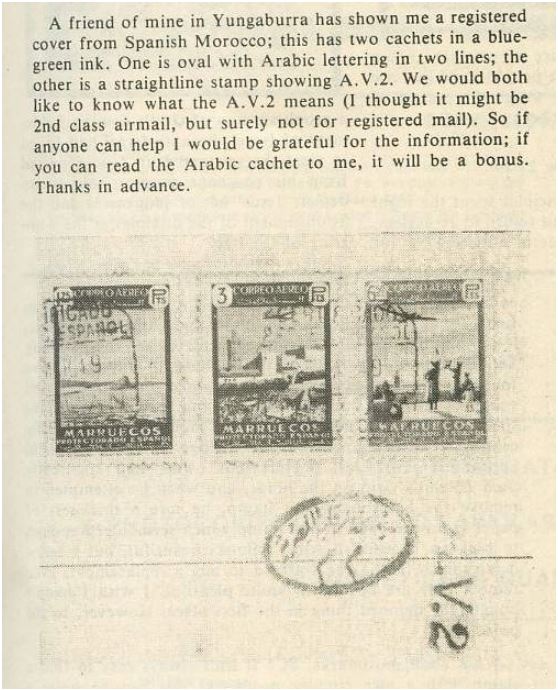Spanish Morocco.
Rare Airmail markings : Their Identification V.A.2 and O.A.T
For searching : VAT and OAT
Author : Mr. Blair Stannard. Canada, (Member of "The Stamp Forum")
Print Cutting : Australian Stamp News Circa 1980

Rodney:
The A.V.2 (Avion 2) handstamp refers to a class of Airmail.
It is seen on a number of countries mail from the 1940s to 1960s.
The oval Arabic handstamp is a Censor mark which
is seen in a number of African and Middle East countries.
It is usually seen in blue.
Roland F. Kohl The O.A.T Mark... A New Collection Area
Translated by Charles J . LaBlonde,
from Postal History 14/54 April 1993 .
POSTGESCHICHTE-VERLAG Postfach174 CH-8024 Zürich Switzerland .
Air mail letters from the Second World War are very
popular since they often followed very indirect routes
to avoid the actual war zones.
This is especially true of letters from Switzerland to
overseas destinations. The letters often bear evidence
of censorship and tests for hidden writing, making
them especially interesting for postal history collectors.
The postal administrations of neutral countries tried
their best to find ways of keeping the mail moving to
its intended destination. Air, land and sea routes
were used to do this.
Air mail letters, which in reality could actually travel
only part way by air (often at a reduced postal rate),
would be marked with "Par avion jusqu'a. . .
("By air mail only to.. .)
On the other hand, mail which arrived at a transit
point and was to be forwarded by airmail would
get the mark "O.A.T. "
But only the top letter in the bundle of mail
would get this marking! This explains the relative
rarity of the O.A.T.marking. At the time collectors
first discovered letters bearing the O.A.T. marking
its exact meaning was not clear.
Questions to the Universal Postal Union (UPU)
proved fruitless. In the archives of the British
Post Office the mystery was solved. .. the
letters mean "Onward Air Transmission."
Since this marking, usually in red, appears in
many forms, it makes an interesting research
area. The most recent comprehensive
publication of information about O.A.T. marks
appeared in the monthly "Airpost Journal"
(published by the American Airmail Society)
in December 1991 and January 1992.
It was written by a Canadian, Murray Heifitz.
In his research, he also discovered the
marking "A.V.2."
This is related to a UPU form "Avion 2"
which was applied by the post office of
origin to the top letter of a bundle
(and still is today) .
The form contains the routing of the
bundle, the weight and the number of
letters in the bundle. It serves the
later calculation of the division of the
postage between UPU countries.
The marking A.V.2 then serves the
same purpose as O.A.T. It was used,
according to Heifitz, in Singapore,
Hong Kong, Bangkok, Amman, Cairo,
Tripoli (Libya) and San Francisco from
1940 to 1957 and even later in other
places (eg 1966 in Prague) .
The O.A.T.marking was used, also
according to Heifitz, in London,
Prestwick, Tangiers, Hong Kong
and Amman from 1940 to1945.
Further research will certainly bring
additional facts to light.Heifitz lists
19 types of O.A.T. marks and
22 types of the A.V.2, based upon
around 500 letters.
The A.V.2 marking seems the rarer
of the two. Heifitz estimates that
around 1000 to 1500 examples of
A.V.2 are known to be in
collectors hands. The number could
be somewhat higher, based upon
collector and dealer holdings.
Blair
References:
UPU Convention (Paris 1947)
American Philatelist Sept 1962 Vol 75 #12
--------------------------------------------------------------
Blair, you are right on. The censor mark is Egyptian. The first two words
in the ellipse are illegible (right to left), and could be the "Censorship
Authority", but the third is definitely "Egyptian".
Tony
You are right Tony.
They are still using that censor mark today, in Egypt.
Cairo is a main mail hub in that part of the world.
Blair